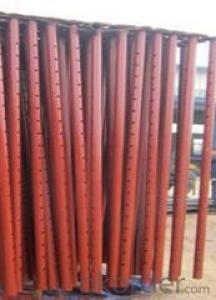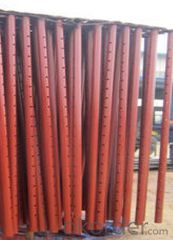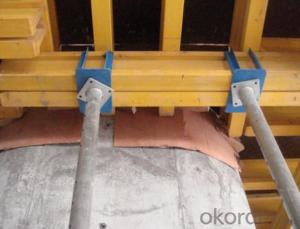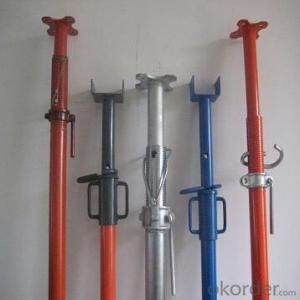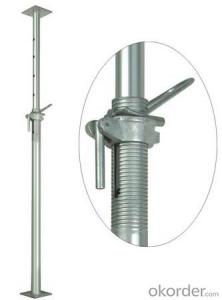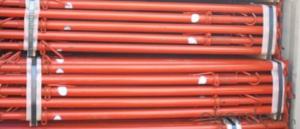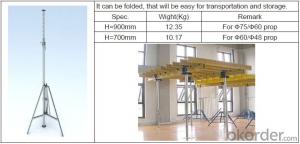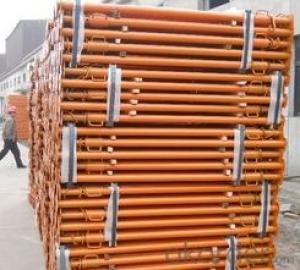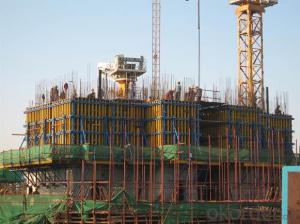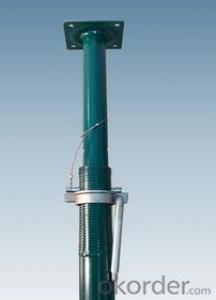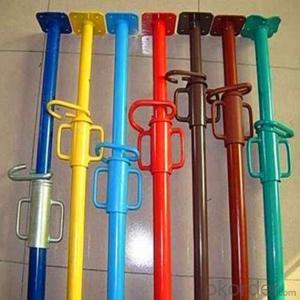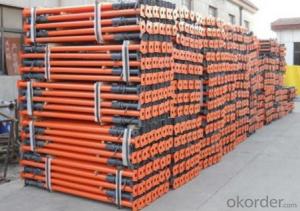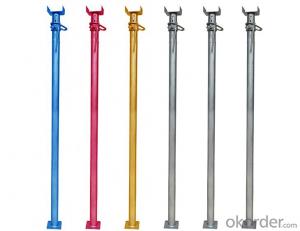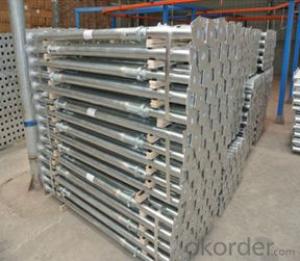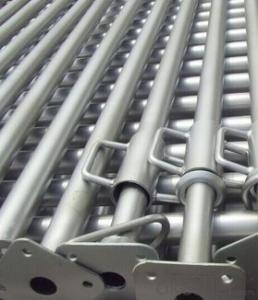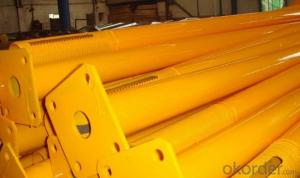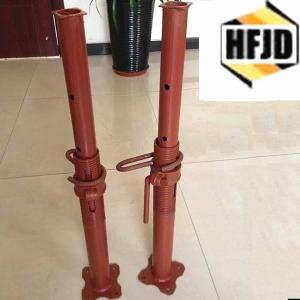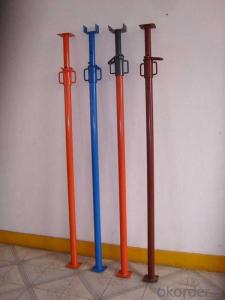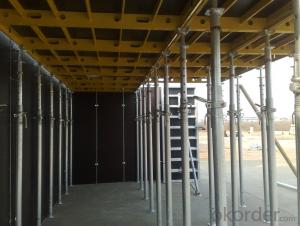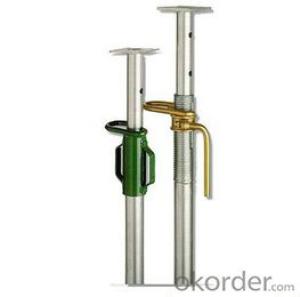Adjustable Steel Prop Scaffolding
- Loading Port:
- China Main Port
- Payment Terms:
- TT OR LC
- Min Order Qty:
- -
- Supply Capability:
- -
OKorder Service Pledge
OKorder Financial Service
You Might Also Like
Quick Details
| Pin: | Base Plate: | Packing: | |||
| Type: | Surface finished: | Material: | |||
| Certificate: | Safe load: | Distance between hole: | |||
| Max length: |
Packaging & Delivery
| Packaging Detail: | In bundles or as your request |
| Delivery Detail: | 20-25days |
Specifications
Adjustable Steel Prop Scaffolding
Surface:Dip-coating,painted
Material:Q235
Certificate:ISO9001-2008
Color:as your request
1 | OUTER TUBE | HR | 60±0.3x2(TH)±0.1 | 5 | BASE PLATE | SS-400 | 120x±1x5(TH)mm/±0.2 |
2 | INNER TUBE | HR | 48±0.3x2(TH)±0.1 | 6 | TOP PLATE | SS-400 | 120x±1x5(TH)mm/±0.2 |
3 | SCREW | SGP | 60±0.3x3(TH)±0.1 | 7 | FIXED PIN | S35C | 9~12±0.4 |
4 | ADJUSTING NUT | FCD | CASTING IRON | 8 | WIRE | SS41 | 12±0.2 |
MODEL | HT-V1 | HT-V2 | TH-V3 | HT-V4 |
Max length(mm) | 3,200 | 3,500 | 3,900 | 4,000 |
Min length(mm) | 1,945 | 2,120 | 2,520 | 2,600 |
Safety load | 1,370 | 1,250 | 1,100 | 980 |
No.of hole | 11 | 12 | 12 | 12 |
Distance Between(mm) | 125 | 125 | 125 | 125 |
Support
*Shoring for construction and civil engineering work
*Easy height adjustment
*Intensive durability and strength
*Simple and easier assemble and dismantle
- Q: How is a steel prop different from other types of props?
- The primary distinctions between a steel prop and other prop types lie in the materials used and the structural strength. Unlike wooden or aluminum props, a steel prop is constructed entirely from steel, resulting in superior durability and load-bearing capacity. One significant advantage of steel props is their ability to withstand heavy loads and provide greater stability to structures. Steel is well-known for its high tensile strength and rigidity, making it an appropriate choice for supporting hefty beams, slabs, or other construction components. Its durability guarantees that the prop remains stable and secure, even under substantial pressure or weight. Another notable difference is the adjustability of steel props. Most steel props are equipped with adjustable features like telescopic tubes or screw mechanisms, enabling users to modify their height as needed. This adaptability is crucial in construction projects that involve varying floor heights or uneven surfaces. Conversely, wooden or aluminum props often have fixed lengths, limiting their versatility in different scenarios. Moreover, steel props offer superior fire resistance compared to wooden props. While wood is susceptible to burning, steel is non-combustible and can endure high temperatures for longer periods. This fire-resistant characteristic makes steel props a safer option in construction sites where fire hazards are a concern. However, it is important to note that steel props can be heavier and more unwieldy to handle than their wooden or aluminum counterparts. The additional weight may necessitate more effort during transportation, setup, and dismantling. Additionally, steel props may have a higher upfront cost compared to wooden props, although their long-term durability and reusability can offset this price difference. In conclusion, a steel prop distinguishes itself from other prop types due to its strength, load-bearing capacity, adjustability, and fire resistance. These features make steel props an excellent choice for construction projects requiring reliable and versatile support for heavy structures.
- Q: What are the safety training requirements for working with steel props?
- The safety training requirements for working with steel props may vary depending on the specific industry and country regulations. However, there are some general safety training requirements that should be considered when working with steel props: 1. Knowledge of steel prop assembly and disassembly: Workers should receive training on the proper methods for assembling and disassembling steel props. This includes understanding the correct sequence of steps, using appropriate tools, and ensuring proper alignment and stability. 2. Load capacity and weight limits: Workers should be trained on the load capacity and weight limits of steel props. This involves understanding the maximum weight that can be safely supported by a prop, as well as the consequences of exceeding these limits. Overloading a steel prop can lead to collapse or failure, posing a significant safety risk. 3. Inspection and maintenance: Regular inspection and maintenance of steel props are crucial for ensuring their safety. Workers should receive training on how to inspect props for damage, such as cracks, bends, or excessive wear. They should also be trained on the appropriate maintenance practices, such as lubrication and cleaning, to keep the props in good working condition. 4. Proper handling and storage: Workers must be trained on the correct techniques for handling and storing steel props. This includes lifting and carrying them safely, using proper lifting equipment if necessary, and storing them securely to prevent accidents or damage. 5. Personal protective equipment (PPE) requirements: Training should include information on the necessary personal protective equipment when working with steel props. This may include wearing safety helmets, gloves, safety footwear, and high visibility clothing to protect against potential hazards. 6. Emergency procedures: Workers should be trained on emergency procedures in the event of an accident or failure involving steel props. This includes knowing how to safely evacuate the area, how to report incidents, and how to administer first aid if necessary. It is important to note that the specific safety training requirements may vary depending on the country, industry, and company policies. It is always recommended to consult with local regulations and guidelines to ensure compliance with the necessary safety standards.
- Q: Can steel props be used for supporting temporary agricultural structures?
- Indeed, temporary agricultural structures can benefit from the utilization of steel props. Possessing great strength and durability, steel props prove to be an optimal choice in enduring the weight and pressure exerted by agricultural structures. These props offer exceptional support and stability to a variety of structures, ranging from greenhouses to shade structures or temporary storage buildings. Moreover, their adjustability enables effortless installation and customization to meet the specific demands of the agricultural structure. Whether supporting the framework or the roof, steel props guarantee stability and longevity, making them a dependable and pragmatic option for sustaining temporary agricultural structures.
- Q: Can steel props be used to support heavy machinery?
- Indeed, heavy machinery can be supported using steel props. Possessing strength and durability, steel props prove to be ideal for offering support and stability to heavy equipment and machinery. They find frequent application in construction sites, industrial environments, and various other scenarios where the burden of substantial loads necessitates support. The adjustable heights of steel props enable customization to suit the specific needs of the machinery being supported. Moreover, their installation and removal are effortless, ensuring flexibility and convenience. Ultimately, steel props emerge as a dependable solution to ensure the secure operation of heavy machinery.
- Q: Can steel props be used in the construction of dams?
- Certainly! Steel props are capable of being utilized in the construction of dams. Referred to as steel supports or steel shoring, these props are commonly employed in construction projects to offer temporary support to structures or excavations. Throughout the process of dam construction, steel props can be utilized at various stages. In the phase of excavation, steel props can be implemented to secure the sides of the excavation, thereby preventing the collapse of soil or rock. This aspect holds immense importance as it ensures the safety of workers and upholds the overall stability of the site. The length of the steel props can be adjusted and they can be installed accordingly to meet the specific requirements of the excavation. Furthermore, during the construction of dam walls, steel props can also be employed. They play a crucial role in supporting the formwork or molds that shape the concrete walls of the dam. By providing stability and strength to the formwork, steel props enable construction workers to pour and shape the concrete in a controlled manner. Moreover, steel props can be utilized during the maintenance or repair of dams. Whenever specific sections of a dam necessitate maintenance or repair work, steel props can be employed to offer temporary support to the surrounding structures. This not only ensures the safety of workers, but also prevents any potential collapse or damage to the dam. In conclusion, steel props are versatile and dependable tools that prove to be highly effective in the construction of dams. They are capable of providing temporary support, stability, and safety, thus making them an indispensable component in the construction and maintenance of dams.
- Q: How do you remove a steel prop?
- To remove a steel prop, you typically need to follow these steps: 1. Ensure safety: Put on protective gear such as gloves and safety goggles to avoid any injuries during the process. 2. Loosen the locking mechanism: If the steel prop has a locking mechanism, such as a pin or a clamp, you need to release it first. Use the appropriate tool to loosen or remove the locking mechanism, allowing the prop to move freely. 3. Gradually reduce the load: If the prop is supporting any weight, gradually transfer the load to an alternate support system. This step is crucial to avoid sudden collapses or accidents. 4. Remove any attachments: If there are any attachments or additional components connected to the prop, such as braces or brackets, remove them carefully. 5. Lower or retract the prop: Depending on the type of steel prop, you may need to lower or retract it. Use the appropriate method specified by the manufacturer to safely lower or retract the prop. 6. Store or transport the prop safely: Once the steel prop is removed, ensure it is properly stored or transported to prevent any damage or injuries. Follow any guidelines provided by the manufacturer for safe storage or transportation. Remember, the specific steps may vary depending on the design and type of steel prop being used. Always refer to the manufacturer's instructions or seek professional advice if you are unsure about the proper removal procedure.
- Q: Can steel props be used to support beams and columns?
- Yes, steel props can be used to support beams and columns. Steel props, also known as scaffolding props or shoring props, are temporary structural devices commonly used in construction to support loads during the construction or renovation of buildings, bridges, or other structures. They are adjustable in height and can be easily installed and removed as needed. Steel props are typically made of high-strength steel, providing the necessary load-bearing capacity to support beams and columns safely. They are commonly used to provide temporary support during the construction of concrete beams and columns, ensuring stability and preventing any structural failure. Steel props are a versatile and reliable solution for providing temporary support to beams and columns during construction projects.
- Q: Can steel props be used for supporting temporary staircases or ramps?
- Yes, steel props can be used for supporting temporary staircases or ramps. Steel props, also known as adjustable props, are commonly used in construction projects to provide temporary support and stability to structures. They are designed to be easily adjustable in height, making them suitable for supporting various types of temporary structures, including staircases and ramps. Steel props are made of sturdy materials, such as steel tubes and plates, which can withstand heavy loads and provide reliable support. Additionally, they can be easily installed and dismantled, making them convenient for temporary construction needs. Overall, steel props are a suitable choice for supporting temporary staircases or ramps due to their strength, adjustability, and ease of use.
- Q: How do you ensure the stability of a steel prop on frozen ground?
- To ensure the stability of a steel prop on frozen ground, there are a few measures that can be taken: 1. Proper Installation: Ensure that the steel prop is installed correctly and securely into the ground. This may involve using a suitable foundation or anchoring system that can withstand the frozen ground conditions. If necessary, consult with a construction engineer or expert to determine the best installation method. 2. Depth and Angle: Consider the depth at which the steel prop is buried into the frozen ground. The deeper it is, the more stable it will be. Additionally, the angle at which the prop is installed can also affect stability. A slight angle away from the load-bearing side can provide better stability. 3. Support System: Consider implementing a support system around the steel prop to provide additional stability. This can involve using braces, struts, or other reinforcements to prevent any lateral movement or instability caused by ground freezing and thawing. 4. Insulation: If possible, insulate the area around the steel prop to prevent the ground from freezing or to minimize the extent of freezing. This can be done by adding insulation materials such as foam or other insulating products around the prop to create a barrier between the steel and frozen ground. 5. Regular Monitoring: Regularly inspect the steel prop and the ground conditions to ensure stability. Check for any signs of movement, cracks, or shifting in the prop or the surrounding ground. If any instability is detected, take immediate action to address the issue before it worsens. It is important to note that the stability of a steel prop on frozen ground may also depend on various factors such as the specific ground conditions, load-bearing requirements, and the overall design of the structure. Therefore, it is advisable to consult with a structural engineer or a professional experienced in working with frozen ground conditions to ensure proper stability and safety.
- Q: How do you prevent steel props from sinking into the ground?
- There are several measures that can be taken to prevent steel props from sinking into the ground: 1. Increasing the size of the base plate can help distribute the weight of the steel prop over a larger area, reducing the chances of sinking. This can provide better stability and prevent it from sinking into the ground. 2. Additional support elements such as timber sleeper boards or steel plates can be added beneath the base plate to distribute the load and provide extra stability. These materials can act as barriers between the steel prop and the ground, reducing the risk of sinking. 3. It is important to consider the soil conditions to prevent sinking. If the ground is soft or loose, additional measures such as using larger plates or adding more support elements may be necessary. Consulting with a geotechnical engineer can help determine the appropriate measures. 4. Opting for adjustable props can provide flexibility in adjusting the height based on the ground conditions. This allows the prop to be elevated above the surface and reduce the risk of sinking. 5. Load-bearing pads, such as rubber or steel plates, can be used beneath the base plate to distribute the weight more evenly and reduce the pressure on the ground. This minimizes the point load on the surface and prevents the prop from sinking. 6. Regular inspections and maintenance of the props and their base plates are important to identify any signs of sinking or instability. Immediate action should be taken if sinking is noticed to prevent accidents or further damage. Considering the specific requirements and conditions of the project is crucial when implementing these measures. Consulting with a structural engineer or construction professional can provide tailored guidance for the specific situation.
Send your message to us
Adjustable Steel Prop Scaffolding
- Loading Port:
- China Main Port
- Payment Terms:
- TT OR LC
- Min Order Qty:
- -
- Supply Capability:
- -
OKorder Service Pledge
OKorder Financial Service
Similar products
Hot products
Hot Searches
Related keywords
